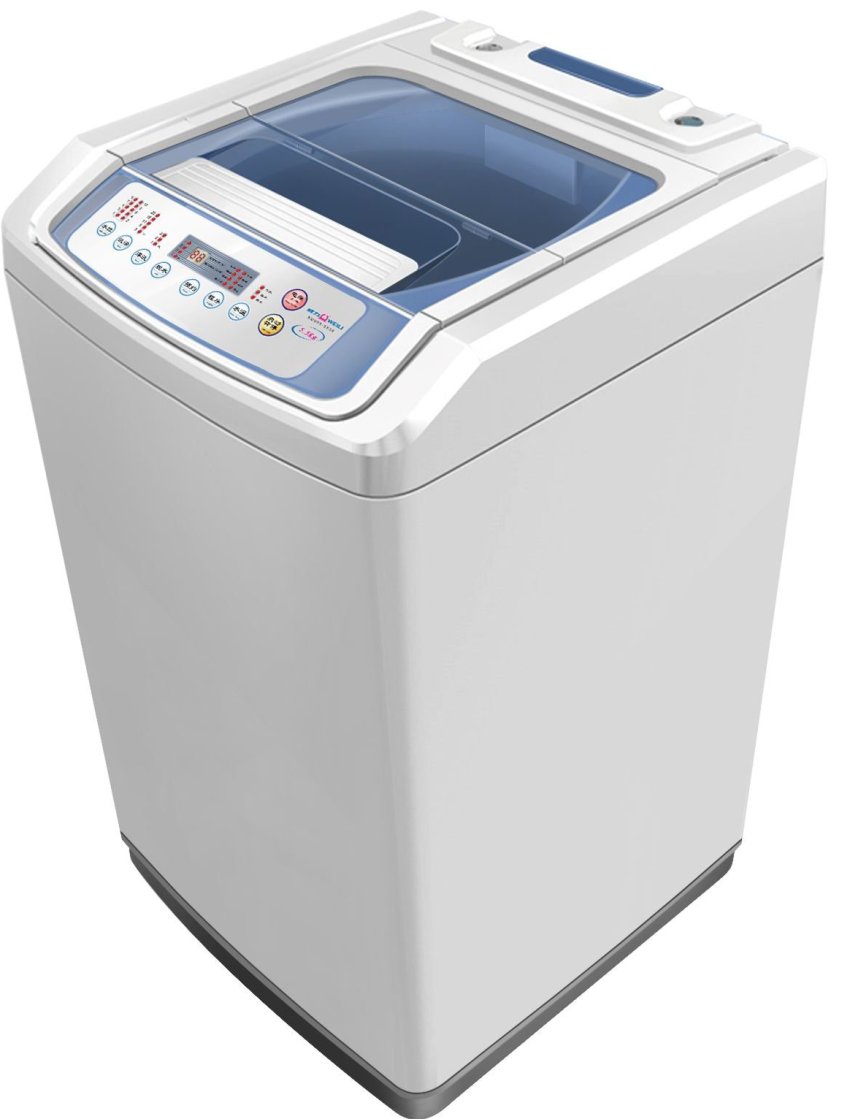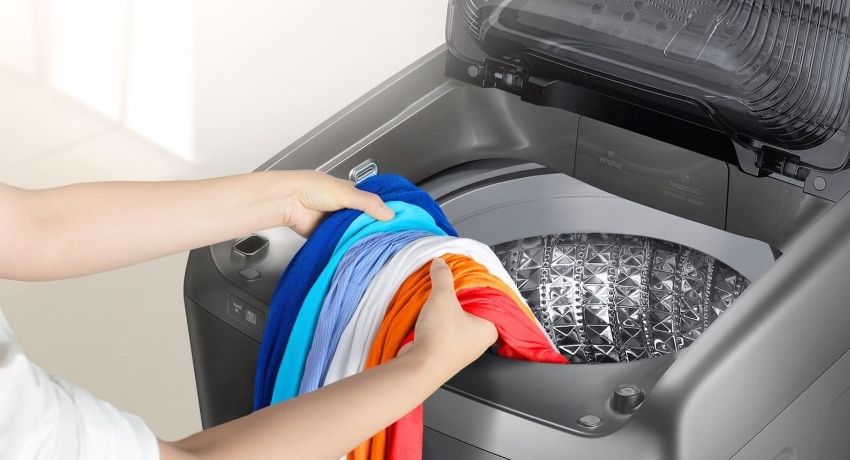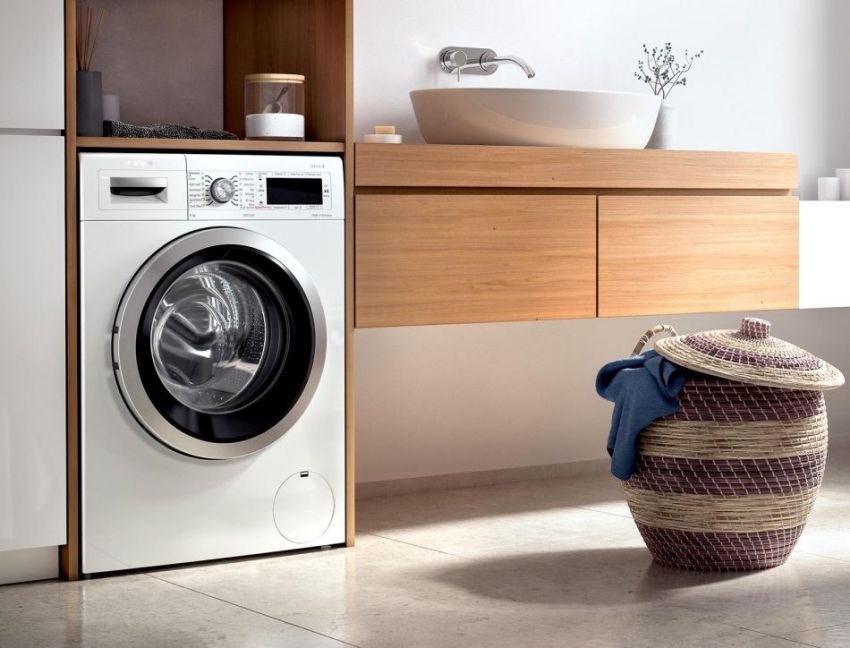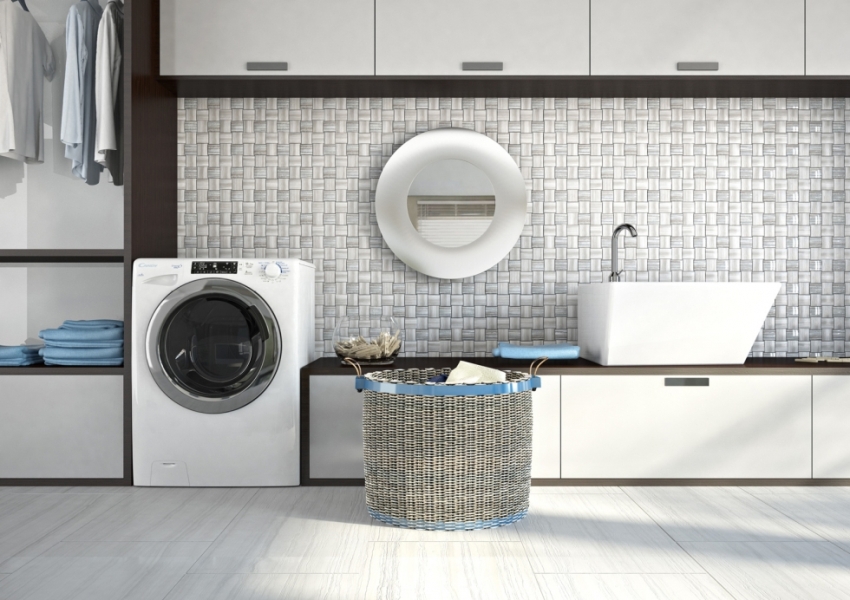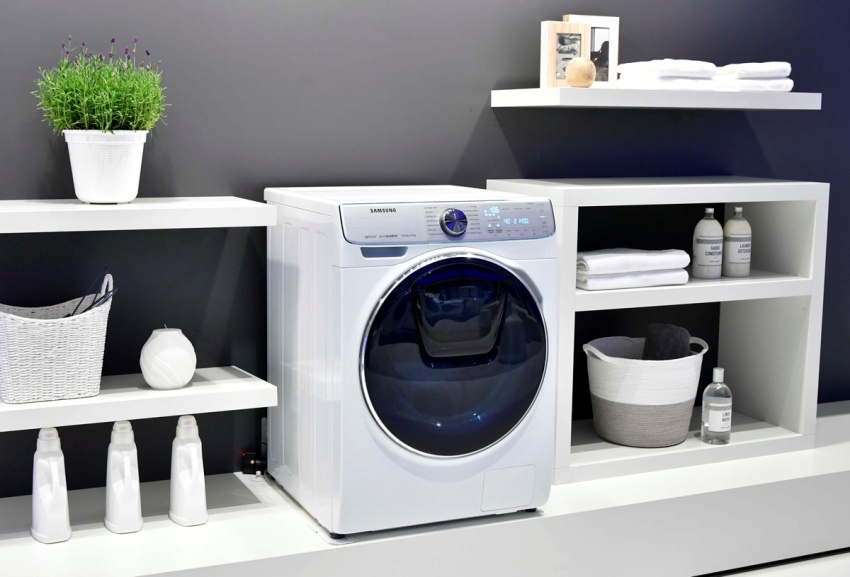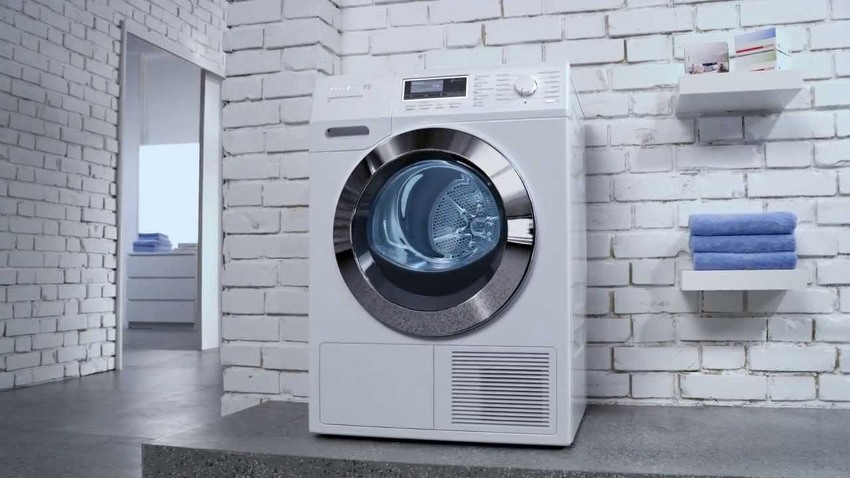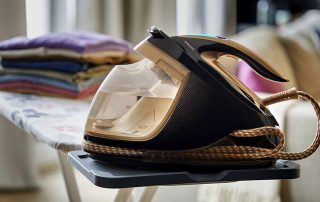Washing and ironing is one of the most routine jobs. The advent of automatic machines is a real breakthrough in housekeeping. The first admiration was caused by the magic transformation of dirty linen into fresh-smelling semi-dry and practically not wrinkled clothes. Gradually, the enthusiastic attitude was replaced by exactingness. In addition, certain sizes of washing machines were needed to improve the operation process.

The place of installation often serves as a hint as to which dimensions and which type of washing machine are best.
Content [Hide]
- 1 Washing machines: dimensions, weight, loading methods, installation
- 2 Width of washing machines and ways of placing them
- 3 How to save usable floor space: washing machines 40 cm wide, 45 cm wide
- 4 The height of the washing machine and its effect on the operating conditions of equipment
- 5 The washing machine is compact and full-size: advantages and disadvantages
- 6 Washing machine sizes: the importance of little things when choosing
Washing machines: sizes, weight, loading methods, installation
Many housewives consider automatic washing machines to be the greatest miracle of household appliances. And it's not just technical excellence. Their use requires minimal physical costs, significant time savings, and the result sometimes exceeds all expectations. There is such a huge variety of modern models that it is sometimes quite difficult to make a choice.
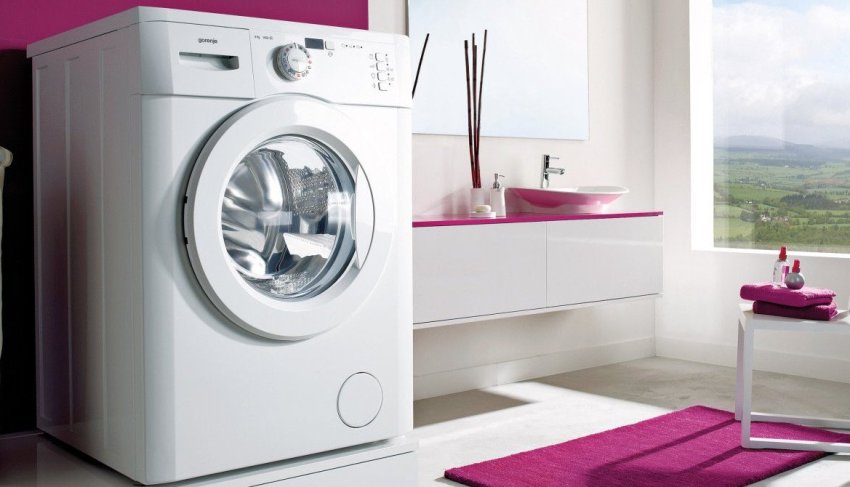
Most often, when choosing, the width of the machine is taken into account, although the height also plays a significant role.
First of all, cars differ in size. They can have different dimensions, both reduced and increased, as well as standard. The internal content also corresponds to certain parameters: the size of the drum, the number of heating elements, fasteners, etc. Taking into account the above characteristics, it is determined how much the washing machine weighs.
By the way of functioning, automatic machines are distinguished with horizontal or vertical loading. Horizontal models have a hatch on the front of the unit. For vertical views, the drum is accessed by lifting the top cover.
Cars are produced that can take a solo position (that is, stand alone), as well as built-in ones. The latter are more often installed in the lower block of kitchen furniture - like ovens and dishwashers.
The main dimensions of washing machines
The dimensions of the washing machine are the first thing that is taken into account when choosing a model, since the location of the device depends on the parameters. Determining the variant of the technique, you can go in two ways:
- Choose the desired type of machine and determine its possible location in the apartment or house.
- Allocate a place for the unit, calculate the parameters and select a suitable model.
Which path to take depends on prioritization.
There are often situations when there is only one possible location for an electrical appliance, and then models with certain dimensions are simply selected.
The main dimensions of the front loading and vertical access washing machines are as follows:
- height (distance from floor to upper plane);
- width (length of the front part);
- depth (distance between the front and back sides).
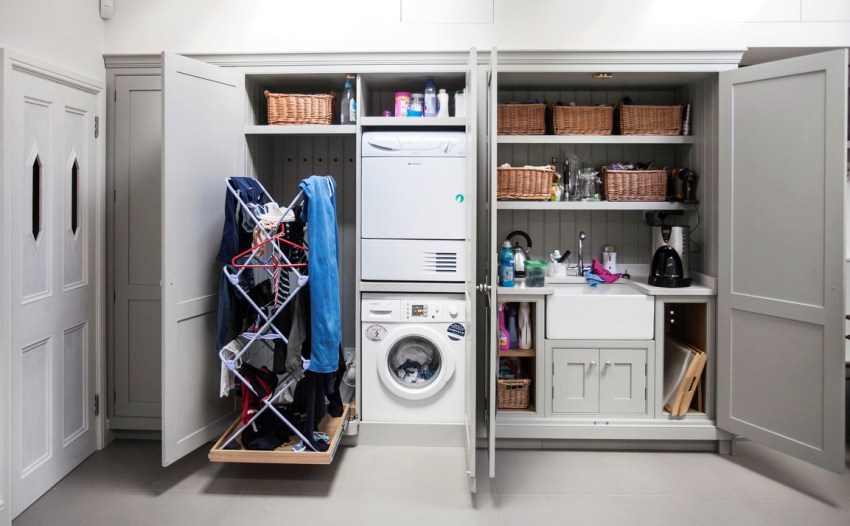
The washing machine has a shape close to a parallelepiped, so its dimensions are characterized by three dimensions: width, height and depth
Helpful advice! When measuring the place for installing the washing machine and comparing them with the dimensions of the unit, it is imperative to take into account the indents from the walls or from other adjacent pieces of furniture or equipment.
Despite the fact that the dimensions of a top-loading washing machine are determined by the same indicators as that of a front-loading washing machine, they have one fundamental difference. Frontal models have more width than depth, vertical ones - depth exceeds width. This difference greatly affects the way this type of equipment is placed.
Indicators of standard sizes of washing machines
With a shortage of space or the existence of any other restrictions, it is especially important to know what sizes of washing machines are. The definition of "standard" is used quite often when evaluating the dimensions of devices. It will also be used in this article, although there are no strict standards. There are simply convenient and most frequently requested dimensions.
These indicators are largely a consequence of the operational characteristics of the machine, or rather, the dimensions of the drum. The amount of the latter, in turn, controls the amount of loaded laundry. From all these causes and effects, conditional standard sizes were formed.
The standard height of machines with both frontal and vertical loading can be considered 85 cm. Such dimensions allow technically correct placement of all parts and mechanisms inside the body and make it comfortable to use.
The standard width of the horizontal loading washing machine is 60 cm. This is a convenient arrangement of the control panel elements, a full-size loading door, a spacious drum. The standard width of vertical machines is 45 cm. It is this indicator that allows this equipment to be built into narrow openings without losing the comfort of use.
The depth of the top-loading machines is 60 cm. This is sufficient for access to the drum and easy loading of laundry. The standard depth for horizontally filled machines is 50–55 cm, but for models with a drying function it may be higher.
Washing machine width and ways of placing them
If the house does not have a separate laundry room, then the most convenient room for installing a washing machine is the bathroom. It provides optimal conditions for the functioning of this household appliance:
- the necessary communications have been installed;
- walls and floors have a moisture resistant coating;
- arrangement of the room allows you to store detergents without harm to health.
Bathrooms are often small, so the width of the washing machine is very important. In a small room, the unit will be located between plumbing or furniture items, and it should not just fit, but occupy a position that allows free loading. It is advisable to leave a space of at least 70 cm in front of the machine.
Helpful advice! When determining the width of the machine for confined spaces, it is necessary to take into account not only the vibration margins, but also the access for cleaning the side surfaces.
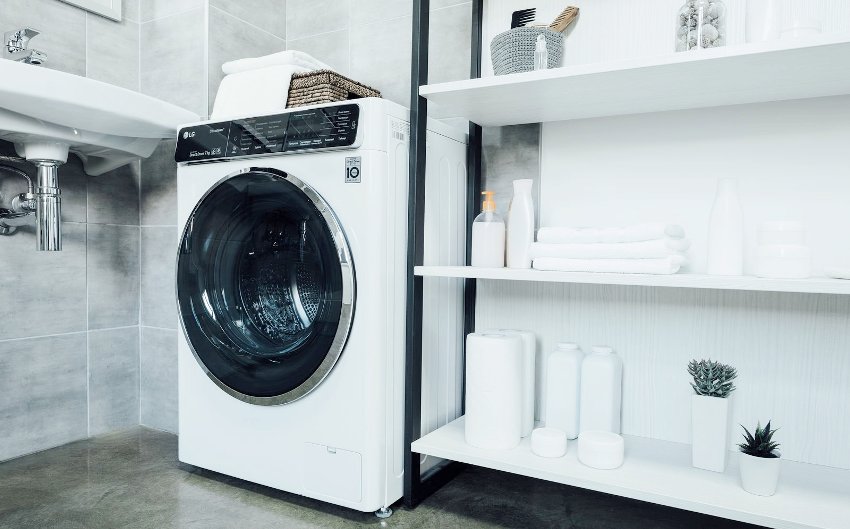
The choice of the width of the washing machine will depend on the room and place where it is planned to be installed
In unity with the width of the automatic machine, its depth is also considered, on which the size of the drum directly depends, and therefore the capacity. Quite often, you have to sacrifice the quantitative value of the load in order to accommodate the equipment. An acceptable option for small rooms is washing machines 45 cm deep with a standard width of 60 cm.
To meet the needs of customers, the modern industry produces washing machines with different widths.
How to save usable space: washing machines 40 cm wide, 45 cm wide
In apartments and houses with combined bathrooms, it is sometimes very difficult to allocate space for an automatic machine, since there is no free part of the wall. In these situations, models with a width of 40 or 45 cm with vertical loading come to the rescue. Such devices are considered small washing machines.
Most often they are installed in corner areas or placed between shower cabins, washbasins, shelves, floor cabinets, etc. The specificity of this type of equipment does not require a large amount of free surrounding space - you only need to provide an approach. Visually, the cars resemble a curbstone or pencil case. They look not bulky, which has a positive effect on the overall perception of the space in the room.
The difference between a 45 cm wide washing machine and a similar 40 cm model is in the dimensions of the drum. The weight of the maximum load of the second option is 1–1.5 kg less.
With a critically small living space, small-sized cars of this type are installed in hallways, located in a place where communications do not need to be pulled along the walls, reducing the space of the room. The compactness of the cases, the modest design of small-sized top-loading machines allow the machines to coexist with furniture without negatively affecting the interior of the premises.
Modest dimensions and full load: washing machines 50 cm wide, 55 cm wide
Washing machines with a width of 50 cm and 55 cm with front loading are classified as small-sized. They are not always purchased for small premises with a limited area. Many people prefer such options due to the rationality of use. The depth of these devices is 39–45 cm. The drum can hold 4–4.5 kg of laundry. This is the optimal weight for a one-off bookmark for the average family of 4.
It is not advisable to purchase a washing machine with a capacity of 6–7 kg in order to wash a blanket or bedspread in it twice a year. Usually the calculation is done based on the bed linen. It can be done as follows: 2 duvet covers (the duvet cover weighs approximately 1 kg); 2 sheets, 2 pillowcases - about 3 kg, you can add a lot more items.
It is unlikely that 4 sets will be put into the machine at once. First, they probably differ in color and fabric quality. Secondly, they must be hung up at the same time to dry, and for this there is not always enough space.
A 55 cm wide washing machine may have a slightly larger drum, and its maximum load is usually 5 kg. Such models are popular for installation in kitchens under the countertop. The depth allows the unit to fit under the work surface, while maintaining the necessary sanitary zone.
Helpful advice! When choosing a washing machine of compact dimensions with a full load (4.5–5 kg), it should be borne in mind that such units are characterized by stronger vibration than full-sized models.
Models of compact vertical washing machines
The minimum width of compact vertical loading machines is 40 cm. The depth, regardless of width, is 60 cm. Such machines are purchased not only for small rooms, but also for rooms with complex layouts. The shape of the body allows you to install equipment in wall niches, piers, in walk-through rooms.

The vertical washing machine cannot be placed under wall cabinets, as opening the lid requires free space
Small-sized vertical washing machines are often bought for summer cottages, where there is no specially designated room for household needs. The machines are installed to the walls through which communications - water and drain - can be connected from the outside.
The freedom to install washing machines with a vertical loading view may be limited by the top position of various items. That is, the unit cannot be placed under wall cabinets, boilers or columns, since opening the lid requires free external space - 50-60 cm (depending on the model).
Related article:
Dryers for clothes: choosing the best model for home use
Types of dryers. Criterias of choice. Rating of the best drying units. Features of the installation of drying machines.
The dimensions of narrow washing machines to some extent limit the functionality of this type of equipment. For half load, for adjusting the dosage of the detergent used, the temperature, etc., sensors are needed that require additional interior space in the housing. The drying function is also impossible with such machine dimensions.
Full Size Top Loading Washing Machines
Some people prefer top-loading washing machines, not because of their compact size, but more because they are convenient to use. No need to bend over to load the laundry. And the condition of the hatch is easier to control, that is, situations are excluded when the machine signals that it is not closed.
If you look through the catalogs of models with vertical loading on sites on the Internet, it can be noted that the dimensions of washing machines are standard in two indicators: width - 40, 45 cm, depth - 60 cm. The capacity of these units is provided by the height. The maximum load is 7 kg at a height of 90 cm.
Some consider it a disadvantage that this type of washing machine does not have a transparent hatch, which allows you to see unwanted objects entering the drum and turn off the equipment.
Top-loading machines are considered to be more durable. There is no statistical data confirming this, but some design features of the devices allow them to be assessed in this way. The drum of such a unit is attached to two oppositely mounted shafts, on which it rotates. Front-loading machines have a shaft on one side and a loading door on the other.
Modern models of oversized machines are equipped with drum parking systems (at the end of the wash, it takes the required position) and the function of additional loading.
Important! The location of the control panel on the top-loading typewriter at the back of the top cover makes it less enticing and more inaccessible to children.
Washing machine height and its impact on the operating conditions of equipment
An important indicator when choosing a technique is the height of the washing machine. Most models have standard indicators - 85 cm. Each machine is equipped with legs, with which you can set the required level and increase the height by 3-4 cm.
For freestanding machines, height is of secondary importance. Considering the small size of typical bathrooms, where this technique is most often placed, and the trend of rational use of space, shelves, cabinets or heating devices are hung over front-loading machines.
Sometimes automatic dryers are placed.
Helpful advice! The space between the upper surface of the machine and the objects placed above should be left so much so that it can be used rationally: for storing various hygiene items, cosmetics, detergents, etc.
As for the dimensions of built-in washing machines, the height is the dominant factor when choosing a model. This parameter should allow the body to fit into the equipped niche.
When installing a top-loading washing machine, the overall height should be calculated with the sunroof raised. In some models, it can reach 130 cm.
Non-standard models: washing machines with a height of 70 cm or less
Narrow washing machines can be placed in a small area, but sometimes there is no free space at all, since preference is given to a comfortable bath or shower box. An original solution may be to place the washing machine under the sink. This installation method cannot be considered simple, since it is necessary to find a washbasin of the required dimensions with an extreme side drain.
In addition to functionality, aesthetic requirements are also imposed on bathroom design. To ensure them, you should think over the supply of communications, choose a machine and a sink that will be harmonious in terms of design.
The requirements for the dimensions of washing machines under the sink are as follows:
- height no more than 70 cm;
- the depth of the machine is 15 cm (at least) less than the depth of the sink;
- the width is 2–4 cm less than the shell width.
Only horizontal loading washing machines are suitable for installation in this position. Finding a model with a small height is not difficult. There are especially many options for 60 cm units.
Helpful advice! When placing the washing machine under the sink, it is better to choose deep washbasin models. This format prevents splashing water as much as possible and allows you to maintain the aesthetics of household appliances.
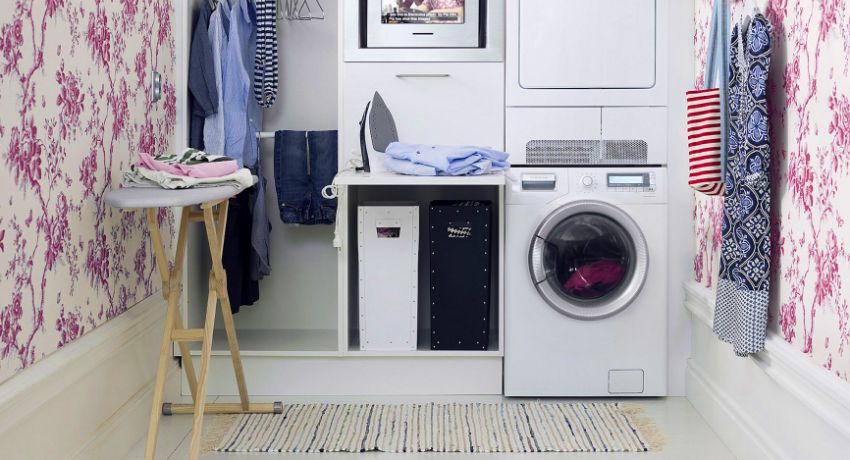
Most often, the height of washing machines varies between 80-90 cm, but models with a height of up to 70 cm are found on the market.
Washing machine 80 cm high: ideal for embedding
Height 80 cm (sometimes 1-2 cm more) is typical for built-in models. Machines designed for this installation method have some structural differences in the case. The lower part is supplemented with a special recess, into which a plinth, common for the lower furniture modules of the kitchen, is installed.
There are hinges on the front side of the machine, which are necessary for hanging the door, which is identical to the front parts of the headset and completely covers the niche. The side parts of the case of built-in washing machines are reinforced with sheets of stamped metal, which protect the equipment from the penetration of moisture vapors, grease and allow the unit to be stably fixed.
The standard height of this type of washing machine can be increased due to the adjustable legs, which for such models have a wide range and can raise the body up to 9 cm above the floor level.
Built-in models of washing machines have a number of undeniable advantages:
- do not violate the interior design of the room;
- allow you to free up space in the bathroom;
- They work silently and have virtually no vibration.
The disadvantages include the high cost and rather small assortment.
Washing machine compact and full-size: advantages and disadvantages
Washing machine dimensions are important when choosing placement conditions. The influence of dimensions and functional characteristics is also important. Both compact options and full-sized models have both advantages and disadvantages. They must be taken into account when choosing this type of household appliance. The advantages of small washing machines include:
- economical water consumption;
- the use of a small amount of electricity;
- the presence of tanks of sufficient capacity (up to 6 kg);
- the possibility of placing on a small area;
- light weight.
Of the shortcomings of compact models, first of all, their price should be distinguished. It would seem that with savings in all respects, the cost should also be appropriate, but the prices for such models, in comparison with full-sized machines with a similar set of functions, are 20-30% higher.
The positive characteristics of automatic washing machines, the dimensions of which correspond to standard indicators, include the following:
- provide an economical consumption of water and electricity due to one-time loading of a large amount of laundry;
- significant weight reduces vibration of the unit during operation;
- almost all washing machines have a pleasant design, full dimensions enhance the presentable appearance of the equipment;
- the width of the loading hatches allows you to place bulky items in the drum.
The disadvantages of oversized machines include the need for a significant amount of space for placement.
Helpful advice! If there is freedom of placement conditions, you should choose the dimensions of the machine that correspond to the required operating power (the amount of load of laundry).

When choosing a small machine, you need to think about whether all things will fit into it for one wash
Washing machine sizes: about the importance of little things when choosing
In order for the acquired miracle of technology - an automatic washing machine - to not cause problems during installation and upset during use, it is worth considering a few points that at first glance may seem secondary:
- It is imperative to measure the doorway. If repairs are not planned, but in order to bring the washing machine, you will need to remove the door frame, problems cannot be avoided. Even with the most careful execution of the work, the aesthetics of the room design will be violated.
- The hatch of the machine must open freely. Even the smallest interference can be annoying over time.
- If the desired loading weight is 5 kg, the size of the washing machine for this amount of laundry can be selected as reduced or full-scale.
- It is not worth buying a full-size machine with a load of 6-7 kg if the average amount of laundry sent for washing is 2-3 kg. This is fraught with either a constant awareness of the irrationality of using the technical power of the machine, or the thought of "turning on-not turning on" for washing a small number of things, or waiting until the optimal weight is accumulated. All three options will make it uncomfortable to use.
- Heavy weight of the washing machine should not be avoided.Delivery to the desired place and installation (possibly removal for repair), although they require physical effort, are still one-time actions. Balancing, which makes the machine heavier the most, will avoid strong vibrations throughout the entire period of use of the equipment.
- When determining the amount of space for installing a washing machine, it is necessary to calculate the parameters of the communication part up to the diameter of the pipes and the dimensions of the fittings.
With the advent of automatic machines in homes, washing has ceased to be the lot of women who manage the household. Any family member of a conscious age, if necessary and desired, can use the technique. Washing machines not only save time and effort for women, but also give them a certain psychological relief. When comparing the quality of hand and machine wash, the advantages are also on the side of the latter. The main thing is to choose the most suitable model correctly.





